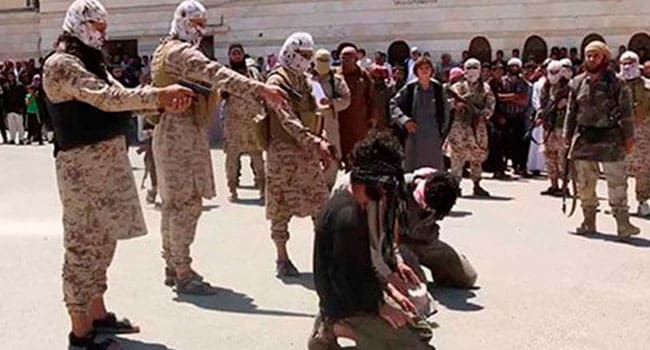 This week marks the 16th anniversary of the attack on the World Trade Center in New York City. It wasn’t the beginning of jihadism or terrorism. Nor was it the first attack by jihadists in Europe or North America. Still, 9/11 marks a beginning. Sixteen years later, however, it’s still unclear what beginning it marks.
This week marks the 16th anniversary of the attack on the World Trade Center in New York City. It wasn’t the beginning of jihadism or terrorism. Nor was it the first attack by jihadists in Europe or North America. Still, 9/11 marks a beginning. Sixteen years later, however, it’s still unclear what beginning it marks.
In the ensuing 16 years of the “war on terror,” the United States and its allies have invaded Afghanistan and toppled the Taliban government. Despite relentless fighting, however, they still have been unable to defeat it or secure rural Afghanistan.
They have also invaded Iraq, removed Saddam Hussein and enabled Iraq’s Shia majority to exercise political power in the area for the first time in more than a millennium.
The U.S. and various allies have also intervened in several jihadist-inspired civil wars, either directly or via proxies, and have supplied arms, financing and military trainers and advisers from Syria to Somalia and from Mali to the Philippines. All this at a cost of trillions of dollars and thousands of lives.
Meanwhile, al-Qaeda, the original jihadist organization, spawned a variety of other jihadist groups. One, Islamic State (IS), seized an area in eastern Syria and western Iraq roughly comparable in size to the United Kingdom, with a population of about five million people, declared a caliphate, and for approximately three years will have ruled the first jihadist state.
Concurrently, al-Qaeda and Islamic State recruited hundreds of thousands of jihadists to take up arms. They also created approximately 100 franchises around the world and backed them with highly sophisticated social media and propaganda efforts.
They also carried out thousands of terrorist attacks, including dozens in Europe, North America and Australia that have left hundreds dead and even more wounded.
While it may be unclear what beginning 9/11 marked, some notable conclusions can be drawn about the threat posed by jihadism and its evolving character.
First, although terrorism is not new, the scope of present jihadist terror networks is unprecedented. Historically, terrorist groups had relatively few members. The groups of the 1970s and 1980s never had more than a few dozen members and several hundred core supporters who they could rely on for help.
In contrast, between 200,00 and 300,000 people have been members of one or more jihadist organizations and have had battlefield experience. At least 10 per cent of these fighters carry European, Canadian or American passports. Many have returned home and joined or organized jihadist cells.
Secondly, the jihadist networks are transnational. This too is unprecedented. Terrorist organizations in the past often had informal links. They would assist each other but for the most part operated independently.
Al-Qaeda and Islamic State, on the other hand, have set up franchises around the world. Each franchise in turn controls multiple cells. Other organizations like Hamas or Hezbollah don’t have franchises but have many affiliated cells in dozens of countries.
Thirdly, those jihadist networks are using their skill sets, access to arms and transnational links to carry out criminal activities on an international basis. The Taliban has become a major player in the Afghan narcotics trade. It’s estimated that between 65 and 90 per cent of Afghan’s heroin, now 90 per cent of the world’s supply, passes through Taliban hands.
Islamic State has become increasingly involved in the marijuana trade in Europe, as well as profiting from its involvement in the North African illegal migrant trade, and the looting and sale of antiquities.
This isn’t the first time that terrorist organizations turned to criminal activities to finance their operations. Organizations like the Brigate Rosse and Baader-Meinhof robbed banks or kidnapped prominent individuals for ransom. Nineteenth century anarchist groups did the same.
Over the next several decades, it’s likely that many of today’s jihadist groups will spawn new global criminal syndicates. The transformation is already well under way.
Fourthly, jihadist organizations not only recruit and radicalize members remotely via social media, but they can exist and continue operating in cyberspace.
Even after their leaders are killed, their speeches and proselytizing continue unhindered across the Internet.
This cyber aspect of contemporary jihadism has also given rise to the lone wolf terrorist. A lone wolf is a jihadist who is radicalized remotely and carries out acts of terrorist violence with minimal if any direction or assistance from the central organization.
Fifthly, jihadist terrorists have gone decidedly low tech. Following 9/11, there was widespread concern among western governments that jihadist organizations would obtain weapons of mass destruction.
The U.S.-led invasion of Iraq was justified, in part, on the supposed fear that Saddam Hussein might supply such weapons – chemical, biological and even nuclear – to jihadist organizations. Intelligence obtained from raids on jihadist organizations confirmed that their leaders were intent on obtaining or creating weapons of mass destruction.
Recent attacks, however, have not involved high-tech weaponry or weapons of mass destruction. Instead, they’ve involved readily available automatic weapons, simple improvised explosive devices and the use of vehicles to run down civilians.
Islamic State and al-Qaeda have shown remarkable talent at improvising weaponry from common household items. The most recent innovations: grenade-dropping toy drones and a bomb packed inside a doll.
Such attacks will not create mass casualties like those on 9/11, but they are tragic for those killed or injured by them. They can create a climate of fear and apprehension that poisons the social fabric of a community, causes suspicions of immigrants and minorities, and leads to a polarization of society.
The rise of right-wing anti-migrant groups is a direct result of the climate of fear created by persistent terrorist attacks.
Sixteen years into the war on terror, are we winning?
No.
The U.S. has succeeded in killing Osama bin Laden and scores of al-Qaeda leaders. The U.S. also killed Abu Musa al-Zarqawi, the founder of Islamic State, and the Russians claim to have killed Abu Bakr al-Baghdadi, the most recent IS leader.
The U.S. and its allies have ejected Islamic State from Mosul and virtually all the territory it once controlled in Iraq. Likewise, they have rolled back IS in Syria and liberated about half of the Syrian city of Raqqa, where Islamic State has its capital.
But the level of terrorist violence around the world continues to increase. Jihadist organizations continue to spread, and their ability to recruit and radicalize converts continues unabated.
Jihadism has a broad appeal to a small percentage of the world’s Muslims. But that still amounts to several hundred million people. Only a tiny percentage of those supporters will ever take up arms or engage in acts of terrorist violence, but that still leaves a pool of several million potential jihadists, and several tens of millions of supporters and sympathizers.
The U.S. has focused on destroying jihadist organizations and their leadership. But no sooner is one leader killed than another comes forward to take their place. Even if a jihadist organization is destroyed, new organizations rise up in their place.
We’ve spent the last 16 years fighting the symptoms of jihadism but we’ve made little progress in dealing with its root causes. It’s not even clear if western governments are equipped to understand or address them.
The number of militants who have graduated from conflicts in Syria, Iraq, Libya, Somalia and elsewhere in North Africa and the Middle East are far greater than the jihadists who emerged from the Afghanistan war. They’ve only just begun to organize their campaign against the West.
The wave of jihadist violence that has engulfed the West over the last 16 years is just the beginning. The beginning of what remains to be seen.
Joseph Micallef is an historian, best-selling author and, at times, sardonic commentator on world politics.
Joseph is a Troy Media Thought Leader. Why aren’t you?
The views, opinions and positions expressed by columnists and contributors are the author’s alone. They do not inherently or expressly reflect the views, opinions and/or positions of our publication.

